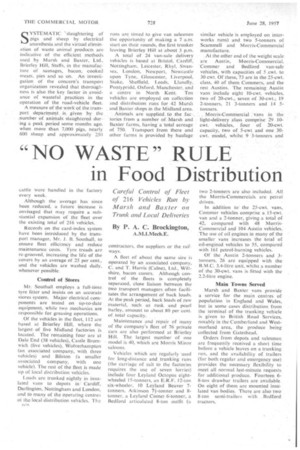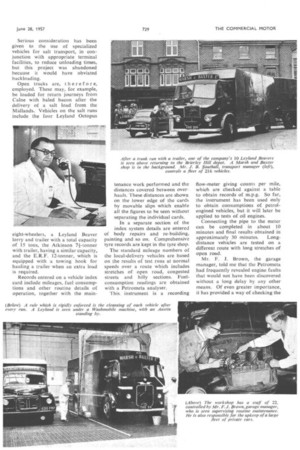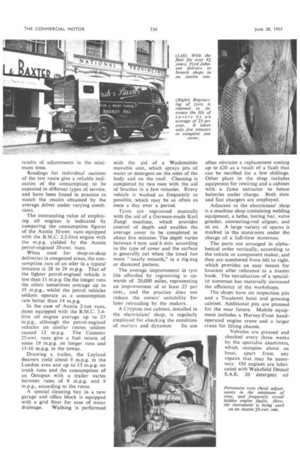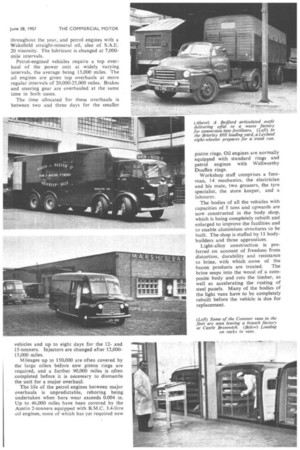"NO WASTE" RULE in Food Distribution
Page 64

Page 65

Page 66

Page 67

If you've noticed an error in this article please click here to report it so we can fix it.
Careful Control of Fleet of 216 Vehicles Run by Marsh and Baxter on Trunk and Local Deliveries
By P. A. C. Brockington,
A.M.I.Mech.E. SYSTEMATIC *slaughtering of pigs and sheep by electrical anxsthesia and the virtual elimination of waste animal products are indicative of the efficient methods used by Marsh and Baxter, Ltd.. Brierley Hill, Staffs, in the manufacture of sausages, bacon, cooked meats, pies and so on. An investigation of the concern's transport organization revealed that thoroughness is also the key factor in avoidance of wasteful practices in the operation of the road-vehicle fleet.
A measure of the work of the transport department . is given by the .ntimber of animals slaughtered dor,ing a peak period some months ago, when more than 7,000 pigs, nearly 600 sheep and approximately 250
cattle were handled in the factory every week.
Although the average has since been reduced, a future increase is envisaged that may require a substantial expansion of the fleet over the existing total of 216 vehicles.
Records on the card-index system have been introduced by the transport manager, Mr. J. B. Southall, to ensure fleet efficiency and reduce maintenance costs. Tyre treads are re-grooved, increasing the life of the covers by an average of 25 per cent., and the vehicles are washed daily, whenever possible.
Control of Stores
Mr. Southall employs a full-time tyre fitter and insists on an accurate stores system. Major electrical components are tested on up-to-date equipment, while two mechanics are responsible for greasing operations.
Of the vehicles in the fleet, 112 are based at Brierley Hill, where the largest of five Midland factories is located. The remaining four are at Dale End (38 vehicles), Castle Bromwich (five vehicles), Wolverhampton (an associated company, with three vehicles) and Bilston (a smaller associated company, with one vehicle). The rest of the fleet is made up of local distribution vehicles.
Loads are trunked nightly in insulated vans to depots in Cardiff, Darlington, Nottingham and London, and to many of the operating Centres 01 1he local distribution vehicles. The runs arc timed to give van salesmen the opportunity of making a 7 a.m. start on their rounds, the first trunker leaving Brierley Hill at about 3 p.m.
A total of 24 van-sale delivery vehicles is based at Bristol, Cardiff, Nottingham, Leicester, Rhyl, Swansea, London, Newport, Newcastle upon Tyne, Gloucester, Liverpool, Stoke, Sheffield, Leeds, Llanelly, Pontypridd, Oxford, Manchester. and a centre in North Kent. Ten vehicles are employed on collection and distribution runs for 42 Marsh and Baxter shops in the Midland area.
Animals. are Supplied. to the fac•. tories from a number of. Marsh and Baxter farms, having 'a 'total acreage of 750. Transport from there and other farms is provided by haulage contractors, the suppliers or the railways.
A fleet of about the same size is operated by an associated company. C. and T. Harris (Caine), Ltd., Wiltshire, bacon curers. Although control of the fleets is completely separated, close liaison between the two transport managers often facilitates the arrangement of back loads. At the peak period, back loads of raw material, such as rusk and pearl barley, amount to about 80 per cent. of total capacity.
Maintenance and repair of many of the company's fleet of 76 private cars are also performed at Brierley Hill. The largest number of one model is 40, which are Morris Minor saloons.
Vehicles which are regularly used for long-distance and .trunking runs (the carriage of salt to the factories requires the use of seven lorries) include four Leyland Octopus eightwheeled 15-tonners, an E.R.F. 12-ton six-wheeler, 10 Leyland Beaver 7tonners, Atkinson 7-1--tormer and 8tonner, a Leyland Comet 6-tonner, a Bedford articulated 8-ton outfit (a
similar vehicle is employed on interworks runs) and two 5-tonners of Scammell and Morris-Commercial manufacture.
At the other end of the weight scale are Austin, Morris-Commercial, Cominer and Bedford van-sate vehicles, with capacities of 5 cwt. to 30 cwt. Of these, 73 are in the 25-cwt. class, 40 of them Commers, and the rest Austins. The remaining Austin vans include eight 10-cwt. vehicles, two of 20-cwt., seven of 30-cwt.; 19 2-tonners, 21 3-tonners and 14 5tonners.
Morris-Commercial vans in the light-delivery .class comprise 29 10cwt. vehicles, four of 20-cwt. capacity, two of 5-cwt and one 30cwt. model, whilst 9 3-tonners and two 2-tonners are also included. All the Morris-Commercials are petrol driven.
In addition to the 25-cwt. vans, Cornmer vehicles comprise a 15-cwt. van and a 2-tonner, giving a total of 42, compared with 48 MorrisCommercial and 104 Austin vehicles, The use of oil engines in many of the smaller vans increases the total of oil-engined vehicles to 55, compared with 161 petrol-burning vehicles.
Of the Austin 2-tonners and 3boners, 26 arc equipped with the B.M.C. 3.4-litre unit, whilst a number of the 30-cwt. vans is fitted with the 2.2-litre engine.
Main Towns Served
Marsh and Baxter vans provide a service for the main centres of population in England and Wales, but in some cases distribution from the terminal of the trunking vehicle is given to British Road Services, notably in the Cumberland and Westmorland area, the produce being collected from Gateshead.
Orders from depots and salesmen are frequently received a short time before a vehicle leaves on a trunking run, and the availability of trailers (for both regular and emergency use) provides the necessary flexibility to meet all normal last-minute requests for additional produce. Fourteen 68-ton drawbar trailers are available. On eight of them are mounted insulated van bodies. There are also two 8-ton semi-trailers with . Bedford Jfactors.
Serious consideration has been given to the use of specialized vehicles for salt transport, in conjunction with appropriate terminal facilities, to reduce unloading times, but this project was abandoned because it would have obviated backloading.
Open trucks are, therefor e, employed. These may, for example, be loaded for return journeys from Caine with baled bacon after the delivery of a salt load from the Midlands. Vehicles on the salt runs include the four Leyland Octopus eight-wheelers, a Leyland Beaver lorry and trailer with a total capacity of 15 tons, the Atkinson 71-tonner with trailer, having a similar capacity, and the E.R.F. 12-tonner, which is equipped with a towing hook for hauling a trailer when an extra load is required.
Records entered on a vehicle index card include mileages, fuel consumptions and other routine details of operation, together with the main
tenanee work performed and the distances covered between overhauls. These distances are shown on the lower edge of the cards by movable slips which enable all the figures to be seen without separating the individual cards.
In a separate section of the index system details are entered of body repairs and re-building, painting and so on. Comprehensive tyre records are kept in the tyre shop.
The standard mileage numbers of the local-delivery vehicles are based on the results of test runs at normal speeds over a route which includes stretches of open road, congested streets and hilly sections. Fuelconsumption readings are obtained with a Petrometa analyser.
This, instrument is a recording how-meter giving counts per mile, which are checked against a table to obtain records of m.p.g. So far, the instrument has been used only to obtain consumptions of petrolengined vehicles, but it will later be applied to tests of oil engines.
Connecting the pipe to the meter can be completed in about 10 minutes and final results obtained in approximately 30 minutes. Longdistance vehicles are tested on a different route with long stretches of open road.
Mr. R J. Brown, the garage manager, told me that the Petrometa had frequently revealed engine faults that would not have been discovered without a long delay by any other means. Of even greater importance, it has provided a way of checking the
results of adjustments in the minimum time.
Readings for individual sections of the test route give a reliable indication of the consumption to be expected in different types of service, and have been found in practice to match the results obtained by the average driver under varying conditions.
The outstanding value of employing oil engines is indicated by comparing the consumption figures of the Austin 30-cwt. vans equipped with the B.M.C. 2.2-litre engine with the m.p.g. yielded by the Austin petrol-engined 20-cwt. vans.
When used for shop-to-shop deliveries in congested areas, the consumption rate of an oiler in a typical instance is 28 to 29 m.p.g. That of the lighter petrol-engined vehicle is less than 11 m.p.g. On the longer runs the oilers sometimes average up to 35 m.p.g., whilst the petrol vehicles seldom operate at a consumption rate better than 14 m.p.g.
In the case of Austin 2-ton vans, those equipped with the B.M,C. 3.4litre oil engine average up to 25 m.p.g., although the petrol-engined vehicles on similar loutes seldom exceed 12 m.p.g. The Commer 25-cwt. vans give a fuel return of some 19 m.p.g. on longer runs and 15-16 m.p.g, in the towns.
Drawing a trailer, the Leyland Beavers yield about 9 m.p.g. in the London area and up to 13 m.p.g. on trunk runs and the consumption of an Octopus with a trailer varies between rates of 8 m.p.g. and 9 m.p.g., according to the route.
A special cleaning bay in a new garage and office block is equipped with a grid floor for ease of water drainage. Washing is performed
with the aid of a Washmobile movable unit, which sprays jets of water or detergent on the sides of the body and on the roof. Cleaning is completed by two men with the aid of brushes in a few minutes. Every vehicle is washed as frequently as possible, which may be as often as once a day over a period.
Tyres are regrooved manually with the aid of a German-made Karl Zangl machine, which provides control of depth and enables the average cover to be completed in about five minutes. The depth varies between 4 mm. and 6 mm. according to the type of cover and the surface is generally cut when the tread has worn "nearly smooth," in a zig-zag or diamond pattern.
The average improvement in tyre life afforded by regrooving is upwards of 20,000 miles, representing an improvement of at least 25 per cent., and the practice does not reduce the covers' suitability for later retreading by the makers.
A Crypton test cabinet, installed in the electricians' shop, is regularly employed for checking the condition of starters and dynamos. Its use often obviates a replacement costing up to £20 as a result of a fault that can be rectified for a few shillings. Other plant in the shop includes equipment for rewiring and a cabinet with a fume extractor to house batteries under charge. Both slow and fast chargers are employed.
Adjacent to the electricians' shop is a machine shop containing welding equipment, a lathe, boring bar, valve grinder, connecting-rod aligner, and so on. A large variety of spares is stocked in the storeroom under the charge of a full-time storeman.
The parts are arranged in alphabetical order vertically, according to the vehicle or component maker, and they are numbered from left to right, which provides an easy means for location after reference to a master book. The introduction of a specialist storetnan has materially increased the efficiency of the workshops.
The shops have six inspection pits and a Tecalemit hoist and greasing cabinet. Additional pits are planned for the near future. Mobile equipment includes a Harvey-Frost handoperated engine crane and a larger crane for lifting chassis.
Vehicles are greased and checked every three weeks by the specialist examiners, which occupies about an hour, apart from any repairs that may be necessary. Oil engines are lubricated with Wakefield Deus& S.A.E. 20 detergent oil
throughout the year, and petrol engines with a Wakefield straight-mineral oil, also of S.A.E. 20 viscosity. The lubricant is changed at 7,000mile intervals.
Petrol-engined vehicles require a top overhaul of the power unit at widely varying intervals, the average being 15,000 miles. The oil engines are given top overhauls at more regular intervals of 20,000-25,000 miles. Brakes and steering gear are overhauled at the same time in both cases.
The time allocated for these overhauls is between two and three days for the smaller piston rings. Oil engines are normally equipped with standard rings and petrol engines with Wellworthy Duafiex rings.
Workshop staff comprises a foreman, 14 mechanics, the electrician and his mate, two greasers, the tyre specialist, the store keeper, and a labourer.
The bodies of all the vehicles with capacities of 5 tons and upwards are now constructed in the body shop, which is being completely rebuilt and enlarged to improve the facilities and to enable aluminium structures to be built. The shop is staffed by 11 bodybuilders and three apprentices.
Light-alloy construction is preferred on account of freedom from distortion, durability and resistance to brine, with which some of the
bacon products are treated. The brine seeps into the wood of a composite body and rots the timber, as well as accelerating the rusting of steel panels. Many of the bodies of the light vans have to be completely rebuilt before the vehicle is due for replacement.








































































































































